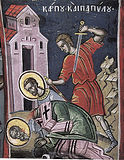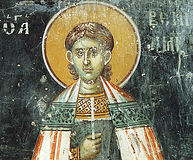

| Previous day | Next day |
| Old Style
October 13
|
Friday |
New Style
October 26
|
|
22nd Week after Pentecost.
Tone 4.
Fast Day. |
Wine and oil allowed.
|
![]() Translation to Moscow of the Iveron Icon of the Most Holy Theotokos.
Translation to Moscow of the Iveron Icon of the Most Holy Theotokos. ![]() Hieromartyrs Carpus, bishop of Thyateira, and Papylus, deacon, and Martyrs Agathadorus and Agathonica, at Pergamus (251).
Hieromartyrs Carpus, bishop of Thyateira, and Papylus, deacon, and Martyrs Agathadorus and Agathonica, at Pergamus (251).
Martyr Florentius of Thessalonica (1st c.-2nd c.). Hieromartyr Benjamin, deacon, of Persia (421-424). St. Nicetas the Confessor, of Paphlagonia (ca. 838). St. Benjamin of the Kiev Caves (14th c.). New Martyr Zlata (Chryse) of Meglin, Bulgaria (1795). St. Anthony, metropolitan of Chkondidi, Georgia (1815), and his disciple James the Elder, hieromonk.
Kazan Icon of the Most Holy Theotokos “Of the Seven Lakes” (17th c.).
St. Venantius, abbot, of the monastery of St. Martin in Tours (Gaul) (400). St. Luke of Demena, Sicily (984). Monk-martyr Jacob of Hamatoura Monastery (Lebanon) (late 13th. c.).
Repose of Monk Athanasius of Valaam (1852).
Thoughts for Each Day of the Year
According to the Daily Church Readings from the Word of God
By St. Theophan the Recluse

Friday. [Col. 2:1-7; Luke 9:12-18]
The miraculous filling of the multitude in the desert is an image of the filling of the faithful in holy communion with the Most Pure Body and Most Pure Blood of the Lord. The Lord is sitting apart; the multitude is made to sit in groups; the apostles are intermediaries—they receive the bread and give it out. So it is now: believers are all divided into groups—small individual churches in which the Lord, invisibly present, gives out His Body and Blood through the apostolic successors. As He did to the apostles then, so now to their successors does He say, Give ye them to eat. As then, so now do the believing multitudes stand steadfastly before the Lord in fasting, hearing the word, and a prayerful desire be healed from sins as they prepare to approach the Divine Mysteries. Thus the mystery begun by the Lord’s appearance continues until now and will continue until the end of the world. And in the world to come there will be a communion of its own sort, for the Lord promises to give to eat of the hidden manna and of the tree of life (Rev. 2:7,17). Our forefathers’ own mystical communion was also arranged in the earthly paradise—eating from the tree of life. In the Old Testament Church its image is the eating of the paschal lamb. Thus, mystical communion began with the human race, was and will be with it until eternal ages, in various forms, but in the one meaning of the most true communion with the Lord; for In Him was life; and the life was the light of men (John 1:4). It is fitting for those who are created according to the image of God to be in such communion with Him, Who being the brightness of his glory, and the express image of his person (Heb. 1:3).





